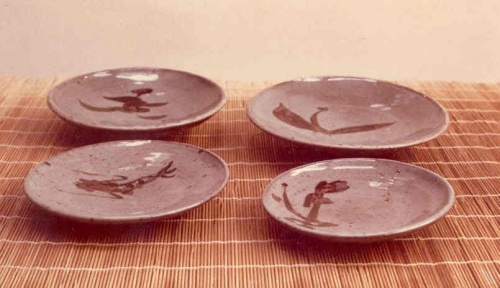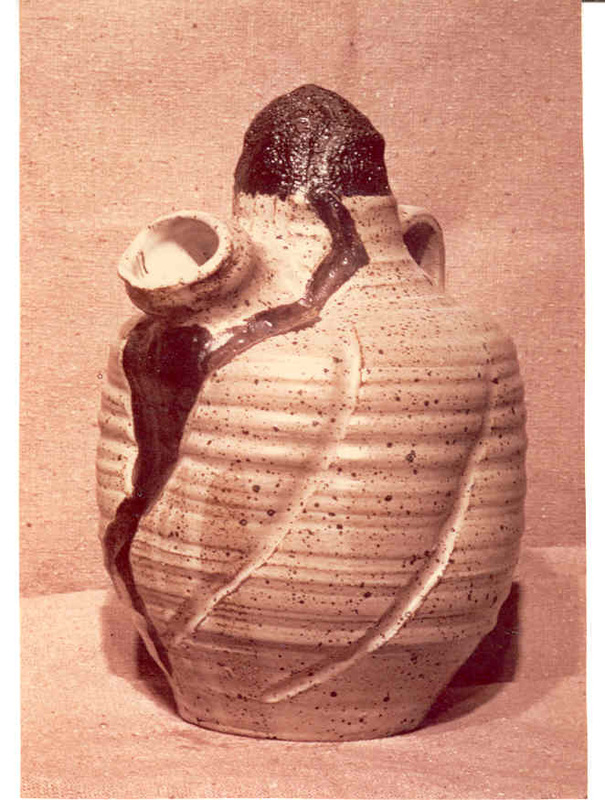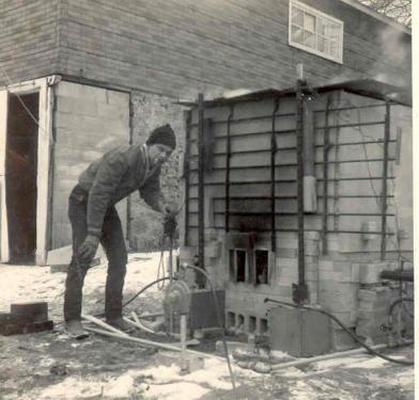Bernard Pyron Stoneware Potter
Click t<meta name="google-site-verification" content="7dLpCJAWpBUvHcP-KxbTRNRZS3SS9x4JK7XXuPUX_DI" /o add description. Lorem ipsum dolor sit amet, consectetur adipiscing elit.
I took courses in pottery under Harvey Littleton and Tom McLaughlin, who was a teaching assistant then. I
remember several of the pottery students of Harvey Littleton,
especially Clayton Bailey, Monona Rossol, Tom McLaughlin, Tom Malone,
Gloria Welniak, and Carlon Welton.
I was a graduate student in experimental psychology, with a Ph.D. minor in art history, mostly the art history of Frank Lloyd Wright under John Kienitz. But I had an interest in pottery going back many years when I dug up grey clay from a nearby ditch and made pots out of it, which i tried to fire in my mother's oven. I started in pottery at the Madison, Wisconsin Vocational School in the late fifties, and the next year I took pottery in the art department of the University.
Clayton Bailey, myself, Monona Rossol, occasionally Gloria Welniak and Carlon Welton, with some other art majors, were part of a group who met regularly to make improvised music based on medieval, far eastern and American folk music with a music major, Dennis Murphy as our leader. Bailey and I were not musicians at all but Dennis taught is to play mouth bows which we made. Bailey still makes them.
Later in the mid sixties,Bailey and I taught at Whitewater State University, where I had an joint appointment in art and education.
I remember one time when Tom McLaughlin got married to a woman whose name I have forgotten, but she was also a pottery student under Littleton. The Littletons were away and let the newly wed couple stay at their house out in the country southwest of Madison. Bailey and I with our wives parked on the road near the Littleton driveway and Bailey and I slipped up to the house and suddenly appeared under the kitchen window.
I was a graduate student in experimental psychology, with a Ph.D. minor in art history, mostly the art history of Frank Lloyd Wright under John Kienitz. But I had an interest in pottery going back many years when I dug up grey clay from a nearby ditch and made pots out of it, which i tried to fire in my mother's oven. I started in pottery at the Madison, Wisconsin Vocational School in the late fifties, and the next year I took pottery in the art department of the University.
Clayton Bailey, myself, Monona Rossol, occasionally Gloria Welniak and Carlon Welton, with some other art majors, were part of a group who met regularly to make improvised music based on medieval, far eastern and American folk music with a music major, Dennis Murphy as our leader. Bailey and I were not musicians at all but Dennis taught is to play mouth bows which we made. Bailey still makes them.
Later in the mid sixties,Bailey and I taught at Whitewater State University, where I had an joint appointment in art and education.
I remember one time when Tom McLaughlin got married to a woman whose name I have forgotten, but she was also a pottery student under Littleton. The Littletons were away and let the newly wed couple stay at their house out in the country southwest of Madison. Bailey and I with our wives parked on the road near the Littleton driveway and Bailey and I slipped up to the house and suddenly appeared under the kitchen window.
Bailey in the spring and
summer of 1962 lived in a rented place out in that same area , but not
as far as Littleton's, where we had a music session around a large
campfire with horns blowing, Murphy playing his sitar, Monona wailing
or singing, some pounding on the drums etc.
I learned to build down draft gas fired stoneware pottery kilns when the larger kiln was built in about 1961 in the University of Wisconsin pottery shop under the Education Building. I built one in Crestwood of Madison and another in Whitewater, Wisconsin. Bailey built a smaller salt glazing kiln beside it.
I learned to build down draft gas fired stoneware pottery kilns when the larger kiln was built in about 1961 in the University of Wisconsin pottery shop under the Education Building. I built one in Crestwood of Madison and another in Whitewater, Wisconsin. Bailey built a smaller salt glazing kiln beside it.
Several of my pots of 1962
In 1961 to 1962 I took
many of my pots to the University of Wisconsin Mall in front of the main
library to sell, and once, shown above, I had my pots at the lake side
of the Student Union Auditorium.
Above, Me Throwing a
Vase In 1962 In My Pottery Studio in the Basement of Our House At 5710
Bittersweet Place In Madison, Wisconsin.
Four of My Celadon
Bowls, With Iron Oxide Brushwork. Three of these were in the Midwest
Designer-Craftsman Show of 1962 and were also in the Smithsonian
Travelling Exhibition that year.
A Celadon Bowl With Iron Oxide Brushwork of 1962.
This Is
One of My Plates of 1962 Made In the Studio Basement at 5710 Bittersweet
Place. I had a downdraft propane gas fired kiln in the backyard at
5720 Bittersweet Place, that I fired up to a little above 2300 F, or to
about cone 10. I built it myself, The brushwork on the plate is wax resist, which shows a darker layer of glaze underneath.
A Stoneware Vase of 1961.
Large Outdoor Lantern of 1962, all wheel-thrown.
Stoneware Jug of 1962, with the top glaze over-fired.
Unglazed Vase of late 1962 after I moved out of 5710 Bittersweet Place.

Above is my Stoneware Downdraft Pottery Kiln At Whitewater, Wisconsin
Here Is A Ceramic Piece
Thrown On My Pottery Wheel In My Studio Above the Garage At Whitewater
and Fired In my Whitewater Kiln Outside the Garage.
Clayton Bailey Built
This Smaller Kiln To Be Used For Salt Firing. It was to the west beside
my larger stoneware kiln. Bailey simplified
the process of building a kiln by using a mix of grog, fireclay and insulating material mixed up with water which he poured in between the firebrick walls of the interior and the forms, which were old tables or boards. The top was a large kiln shelf. When the kiln was fired the insulating material hardened to become like insulating brick. Not using insulating bricks cut down on the cost of the kiln considerably. Note the square opening six inches or so above the bottom. Thats for the propane gas pipe. Bailey put a row of firebricks in front of the to of the gas pipe to form a down draft kiln. The back had to be bricked up each time the kiln was fired. It worked.
the process of building a kiln by using a mix of grog, fireclay and insulating material mixed up with water which he poured in between the firebrick walls of the interior and the forms, which were old tables or boards. The top was a large kiln shelf. When the kiln was fired the insulating material hardened to become like insulating brick. Not using insulating bricks cut down on the cost of the kiln considerably. Note the square opening six inches or so above the bottom. Thats for the propane gas pipe. Bailey put a row of firebricks in front of the to of the gas pipe to form a down draft kiln. The back had to be bricked up each time the kiln was fired. It worked.
The inexpensive quickly
built salt glazing kiln is here ready to fire. See the slot opening in
the side of the kiln? Thats for shoving in small paper cups of wet salt
into the kiln when it reaches about 2300 degrees F. We often fired the
salt kiln, and later the larger kiln was used as a salt glazing kiln,
at night. When the cups of wet salt, often mixed with copper, or
something else for color, were shoved into the white hot kiln, there
would be a small explosion and clouds of white gas would come billowing
out of the blow hole, which you can see at the bottom of the bricked up
back wall.
On the table above, with some smaller ceramic pieces, leaves and apples, are two of my Whitewater Salt Glazed wheel-thrown
pieces. Those are four Frank Lloyd Wright designed chairs from the Ward Willitts house around the table. Thats Patos, my dog, under the table.
pieces. Those are four Frank Lloyd Wright designed chairs from the Ward Willitts house around the table. Thats Patos, my dog, under the table.














No comments:
Post a Comment